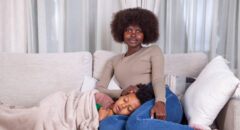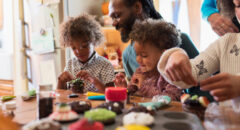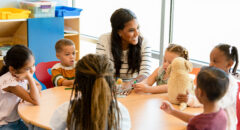
Alexia Doubouya, Founder of Cocolife.black, is a recognized authority on Black Maternal Health. After overcoming personal struggles with Perinatal and Postpartum Depression, grief, and workplace discrimination, she became a Certified Postpartum Doula and advocate for mothers and babies. With a Master’s in Organizational Leadership and certifications in Mental Health Awareness, Alexia empowers mothers, equips birth workers, and advocates for healthy childhood development. She also launched International Coco Mom Day and is a sought-after expert on health equity and childhood milestones, embracing the idea that it truly takes a village.
Q: What inspired you to focus on addressing maternal health care disparities and the prevention of SIDS in Black communities through Coco Life?
A: So about 13 years ago, when we embarked on this journey of creating a community to support moms, I encountered several stories through my personal relationships and then friends of friends. And those stories crossed over a few different stages in maternal health. They crossed over pregnancy, postpartum, and compassion families, mamas, and dads birthing people who experienced the loss of a child. We later expanded, and later, maybe a few months later, because of the experiences that were had by one of our project leads and co-founders, she had lost her husband when seven months pregnant. And so what we expanded to say is that at Cocoa Life, we serve moms in three key stages: pregnancy, postpartum, and compassion for the loss of a child or significant loved one. And so, that’s where the inspiration came from: we weren’t hearing enough conversation. Not saying it didn’t exist because since then we’ve definitely connected with some amazing organizations that focus on loss. And we knew that, especially for black people, that is, unfortunately, a significant part of our story.
Q: Gotcha. So, what factors do you think contribute to black infants being twice as likely to die from SIDS compared to white infants?
A: So there are a few things, some of which, you know, maybe rather common. Or maybe rather familiar; I really dislike when people use that terminology of, “Oh, it’s common.” I’ve heard stories where moms have been told, oh, you had a miscarriage. It’s common for black women, so just try again. And so that’s not the approach we want to take. Right? But when we think about factors, there are things like access to care for healthcare, so actually having healthcare and thankfully, over the years, Obamacare has kind of helped to improve that. But also prenatal care. And in cities like where we are out of, like Philadelphia, access isn’t the only thing. So you could throw a stone and hit several pediatric centers, teaching hospitals, and all those affiliated with maternal health and support.
But it’s what happens when you get there. This leads me to another reason, which is systemic racism and implicit bias on the side of our healthcare providers and those systems that our families have to navigate environmental factors. There are stressors in Philadelphia, again, which was ranked, I think, a couple of years ago as one of the poorest cities. But we have so much wealth in so many other areas. But if you don’t have an opportunity to benefit from that, when you think about social determinants of health that impact us, like food insecurity, housing insecurity, and displacement, those bring in a major piece.
And then, I think one of the other things I would add is education on safe sleep and best practices. Some of that is because of intergenerational influences. Like I remember when I had my daughter 13 years ago, my mom was like, why are you putting that baby on her back? Put her on her stomach because that’s the best way to sleep. And I was like, well, ma, the pediatricians now are saying it’s safer to put on their back. But she was like, but they sleep better. And I’m like, I’m not arguing that. What I’m saying is that it’s safer to sleep. So I think we continue those realms of education, and that’s where doulas even come in to help with that.
RELATED: SIDS Awareness: 5 Things You Can Do To Protect Your Child
Q: So I guess in combination, what role do unsafe sleep environments, such as bedding or bed-sharing and soft bedding, play in SIDS, and how can families create safer sleep environments?
A: So when our babies are first coming into this world, and I know we’ve seen a ton of videos of like, oh, these babies have been here before because they’re holding up their heads, doing all of these advanced physical things, they’re still very vulnerable. And so when you think about how cute the crib bedding things are, I’m honestly bothered. And as time goes on, we know that it does exist, but I’m bothered that they’re even created. Because we’re like, well, they shouldn’t be in the crib. So those factors or those things play a huge part.
In the soft bedding, a baby gets stuck under a pillow, or if they’re not swaddled properly and there are loose blankets around them and they can’t move their face, they can’t grab the blanket and move it off of their face. Right. They’re stuck there. And so now they’re succumbing to the environment that they’re in. So it plays a major part. Even bed-sharing. Moms are tired, though, right? And so, moms are extremely exhausted, so are families.
And so, it becomes easier to just put that baby into bed with you even if you’re breastfeeding. Right? Then, I could just roll over and breastfeed. You can also roll over and do other things. And so we just have to be mindful about these activities that while it may make things easier per se, it’s increasing risk. What things can parents do to kind of create safer environments? Co-sleepers they even have co-sleepers that come right up to the bed. We had one. That makes it easy for you to put that baby right near you. I always tell people that we get stressed out about these nurseries; that baby probably isn’t even going to be in that nursery for a while. And many studies show the importance and the growth of the emotional side of babies when they’re close in proximity as far as sleep.
So get a co-sleeper. Safe sleep products like the SNOO are designed to create safer sleep environments. They can be a little pricey, but they have rental options, too. And not being afraid to share like, hey, in those safe environments, I need a bassinet. I need a crib. That can be in my room. I need a safer sleep option. It’s the same thing with car seats, not letting babies sleep in car seats. We do that a lot. I don’t want to wake up this baby. And so we’ll share a few things with our families to inform them, including taking safe sleep classes. We work with Penn a lot, and our doulas are able to take safe sleep classes through them.
Q: Can you explain some of the common misconceptions surrounding SIDS prevention?
A: I think some common misconceptions are that parents are just lazy or intentional about these things. So many of them are accidental. That’s essentially why mortality can fall under SIDS for infants because we’re not sure what happens. Sometimes, none of these things happen. They’re not in unsafe sleep environments. But the baby can still pass. There could be health complications that one did not know about, and they kind of arose, right? There could be challenges with breathing, things that may not have even come up in an initial pediatric visit. And so I think a misconception is that parents are just lazy. They didn’t care about their kid, which is why this happened, because that is not true. Yes. All those things I said before about the factors that can contribute do come into play. But there are some times when just these things occur, unfortunately. And that’s why we need to learn as many things as we can about the factors that we may not even realize impact us but do, like mental health.
And I think we expect that, parents, even if this isn’t your first pregnancy, right? That you just, you got it all together, and you know it that’s a contributor because you are creating an unsafe, psychologically unsafe environment for these parents or parents to operate with them and care for this child. And so as a community, if we’re not checking on those parents, if we’re not offering to help, if we are not making sure they have access to doula services and lactation support we are helping contribute to this.
Q: When someone brings home a newborn baby, what precautions or safety precautions can they take before that baby is actually in the home?
A: So, taking steps. Like one, again, having a safe environment for the baby to sleep in. I’m going to use an example of a bassinet. You don’t have to get anything super large or super expensive. I know I mentioned the SNOO, but like I said, they even have options to rent it for some healthcare plans. So, some health plans will cover it. So finding out about what’s covered as it relates to your benefit, creating a safe sleep environment. No loose blankets, asking how to swaddle baby at the hospital. Can you please show me how to swaddle?
Sometimes, that swaddling situation is tricky. So, buy some of those swaddlers that have the Velcro on them. Swaddling is not my ministry, but they have made it easy for us to buy these items, and they have sizes. So, make sure to get the right size. Also, asking for help. So, postpartum planning is a big one for me. As a doula, when I’m working with my families, I don’t just talk about our birth plan and preferences. We also talk about post postpartum, like who’s there to support you. I do overnight doula care. Get yourself a doula for postpartum. That’s important.
And it’s a misconception there. It’s like, oh, I can’t afford it. Health plans are starting to cover it. We just saw in Pennsylvania that the Black Maternal Health Caucus, one of the bills that were put forward, was able to gain some traction, thereby covering doula services. So, ensure you have a safe environment for your baby to sleep in. Putting baby on their back to sleep. The American Academy of Pediatrics still supports that. Also, not sleeping with anything for you that could muffle your hearing. Sometimes, people sleep with headphones on, so make sure you can also hear your baby and with them right there in the space with you, too.
Q: You touched on it a little bit, but what role do healthcare providers and public health campaigns play in educating black families about SIDS? And how can we ensure that the information provided is culturally relevant? I know you mentioned the bills that got passed for some of those doulas to be part of health plans and stuff. But what are some other things for families?
A: As far as healthcare providers and the role they can play when this baby arrives, usually, parents are inundated with a lot of information about how to take care of this baby in the hospital. And it’s not reasonable to believe that all of this information will sink in. So I think from the time that person comes into your space, whenever you meet whatever gestational period mom birthing person may be in, and their partner when they come in, start there educating about safe sleep, about you know, asking, talking about getting ready for home. Do you have a car seat? Make sure it’s installed. Try not to let babies sleep in the car seat. Right. Adjusting temperature controls is another thing. Sometimes we’re like, oh, the baby is so cold. If you are walking around with a T-shirt in your house, that baby probably can wear similar clothing.
So, not over dressing that baby because they can get overheated. Making sure that they’re educating families on the importance of smoke detectors and carbon monoxide detectors. Bathing safety is another thing that came to mind as we were discussing things that we can do to prepare and be ready, and providers have a list of that information. So let’s not make assumptions that families are, and as it relates to our bias, those providers, assuming that every black family that comes in there is housing insecure or food insecure, or on the lower socioeconomic side of the spectrum, treating people as humans. These are human rights to be treated well. And with respect and dignity. That’s important.
When we talk about cultural congruency, that’s what we mean. We mean, considering the population that you work in, what hospital systems are you in? What, who are you serving? What resources do you have available that speak to them? Right? Empathy operates with an empathetic lens and not a sympathetic lens. So, I think that is what providers can do to do a better job. And then here’s the biggest thing: connecting and supporting resources that are already doing the work in the community, like CocoLife.Black, you have organizations that focus on preemie support. Like once upon a preemie, I, the list can go on and on of resources that are led by people who look like the folks they’re serving.
And I think our hospital providers or our clinical providers have to do a stronger job of making sure those resources are not just available. So don’t just hand a bunch of papers and say, okay, go be great. But are you connecting with black lactation consultants, you know, who can also help to advance this information?
There is a lot of repetition, you know repetition throughout your appointments that you have during pregnancy. Right. And then that’s the thing right after that, you may have one visit, and then it’s like deuces. That baby has a lot of visits for peds. And so we are thankful for the postpartum expansion that happened in Pennsylvania through Medicaid. So that means more coverage.
But another thing is making sure at that last appointment, if you will, or before then, asking the family, “Hey, have you checked in with your primary care physician, your PCP? Why don’t you go ahead and connect with them to get your appointments scheduled so that you get another visit already scheduled after we see you?” At like that six-week checkup.
Q: We touched on it a little bit, but how important is it for black parents to advocate for themselves and their children in the healthcare settings, especially when it comes to safe sleep education and SIDS prevention?
A: It’s very important. And, and what may seem to be an obvious reason, I’m going to state anyway because the more questions you ask, the more information you can get. Mm-Hmm. And so yes, we are talking about the proactive side of it, which I think is on the providers’ side. And then defining and clarifying what proactive is. Proactive is not shoving a bunch of papers at a family after they just had this baby or shoving a bunch of papers all throughout. It’s creating a conversational experience to talk about these things. But on the side of the parents, if you ask these questions during your prenatal appointments even what suggestions do you have on safe sleep? What classes do you have on safe sleep? What are some things that all the questions you just asked me are great questions?
For families to be able to ask those clinicians in those settings and pediatricians and maybe even as they’re preparing for postpartum to get their first pediatric appointments scheduled, “Hey, what resources do you have besides just pamphlets and things like that? Can you share with me about safe sleep to help reduce SIDS?” I mean, for black families, black infants, and black moms, we are at the highest rates. We experience the highest rates of mortality and morbidity, and a lot of it is, 85 plus percent of it is preventable. And so when you hear data like that, these things were preventable, now we got to start to back into why they were preventable. Because all of this is not just because of, you know, lower socioeconomic conditions or those sorts of factors. A lot of it is how close we are to caring for that family through the systems they navigate.
Q: What immediate steps can communities, organizations, and policymakers take to raise awareness and support black families in reducing SIDS?
A: One is becoming more educated on what things can lead to. What are some of the leading causes of, of SIDs? Like the factors that we talked about early on. Making sure to offer resources like doula services. So, continuing to cover doula services, ask your expecting family member if you have a doula, encouraging them to put that on their registry. Put a doula on your registry. This way, someone can also cover some of those services for you. I think also making sure that families for the providers, again, are aware they have safe sleep classes that they can offer as part of their childbirth education classes—incorporating safe sleep conversations at every single stage of pregnancy.
From the time they walk in, that should be the same thing. One of the questionnaires. And not just do you have a bassinet or a safe place to sleep or do you have a car seat? But are you familiar, I know we don’t want to have these conversations, but October is also pregnancy and infant loss awareness month. And so we have to talk about the things that can lead to that increase in data and statistics because behind every one of those pieces of data is a family. This loss has impacted that, and we can’t, you know, forget about that.
Q: Can you describe the step-by-step process for supporting new parents and caregivers with CocoLife?
A: So, if someone contacts us, whether through referral or they just kind of happen to find us, if you will, in their searches, we will connect them with support groups. We have prenatal and postpartum support groups. We also have support groups for those who have experienced a loss. We connect them with support groups that doulas lead. And then we also have mental health support groups and individual one-on-one. So, the first thing we do is kind of identify what their need is through our doula. So, through our perinatal health equity academy, when they go through training, they’re learning about infant safety, safe sleep, and what things they can keep out for as a doula. We also take our work into hospital systems and into other community-based centers and places to talk about the role of the community.
How can you help be a safe sleep advocate? Learning about, again, the resources that may be available through the Safe Sleep Academy. Like that’s another resource that’s available for learning about the ones that are accessible through the hospitals, too. So our major role is to first identify through that intake process what the need is, the specific need. And then in that kind of community building, we’re constantly talking about whether it’s because of monthly observations or just to make sure the communication centers on infant safety and safety for the family. We are sharing that information, too. Gotcha.
Q: Okay. Once someone is connected where they need to be, how does that go forward? Do they just kind of immerse themselves in where you’ve placed them? Do they come back to you at some point?
A: Yeah, so they’re with us. So, we refer to it as our coco community. So we’re not like just a referral base; hey, come to us, and we refer you out. You stay within the community. All of our resources are within the community. So, our support groups are available monthly. We do edutainment experiences like we’re planning one for this month where we meet and engage with the families. And so they stay connected with us through our different channels of communication. Again, support groups, events that we host, and then as they may connect with different referrals that we’ve made still with them. So we’ll know, hey, how’s it going with those mental health professionals? How did it go when you took that safe sleep training that we may have suggested and referred you to? Because they stay within the community with us.
Q: Gotcha. What advice do you have for Black mothers and caregivers who feel overwhelmed by the pressures of balancing cultural practices with medical advice on infant safety?
A: Because we know how that goes. Like your mom, your grandma might tell you well this is how we did things, blah, blah, blah. But statistics and other information is telling us; I used the example early on about my mom who was like, oh, put that baby on their belly. Or it could be like, oh, you can give that baby water at a month old, or go ahead and put a hole in a nipple and give them some cereal. We know the list goes on and on and expands and beyond. And so I think to that mom, to those people who are feeling overwhelmed at this process, you absolutely have to back away from the noise. I know it sounds trite and difficult, but this is the lesson I had to learn. You have to back away from the noise and you have to start to sift through what is safe and what is intergenerational norms, if you will, that were passed down.
And while they may have meant something at that time, you still have to be sure that you are creating a safe environment for your baby. You are the parent; you are the expert on your baby. You receive the medical advice, and you receive the information that may be shared, but at the end of the day, you are responsible for that baby and for yourself. So, my advice is to make sure you are connected with a mental health practitioner. I know we love talking to our friends, and I know we got our girl group. I’m good. That’s fine. If you have a safe place, the community you’re talking within, that’s fine. But have yourself a mental health professional. It’s a balance, too, between social media and Googling. You’ll get inundated with a lot of information about people saying do this, do this, or this is what I do.
You have to take the time to bond with your baby. It’s also national, international baby wearing week. That is something too that helps with the prevention of SIDS because you are bonding with that baby. That means you’re getting to know the baby a little more fully as parents. Then, take time to talk to your partner if, for any reason, that partner may not be available. A person that you can trust. Right. Having a doula is another thing. Like I’m always going to be an advocate of having a doula at all those stages that you are in, even preconceptions. And then, finally, I think taking the time to give yourself grace and compassion. It can be overwhelming to be a parent, which can happen at any stage, but particularly when the noise feels too loud, you have to give yourself a safe place to go to. And healthy coping strategies to implement, too.








